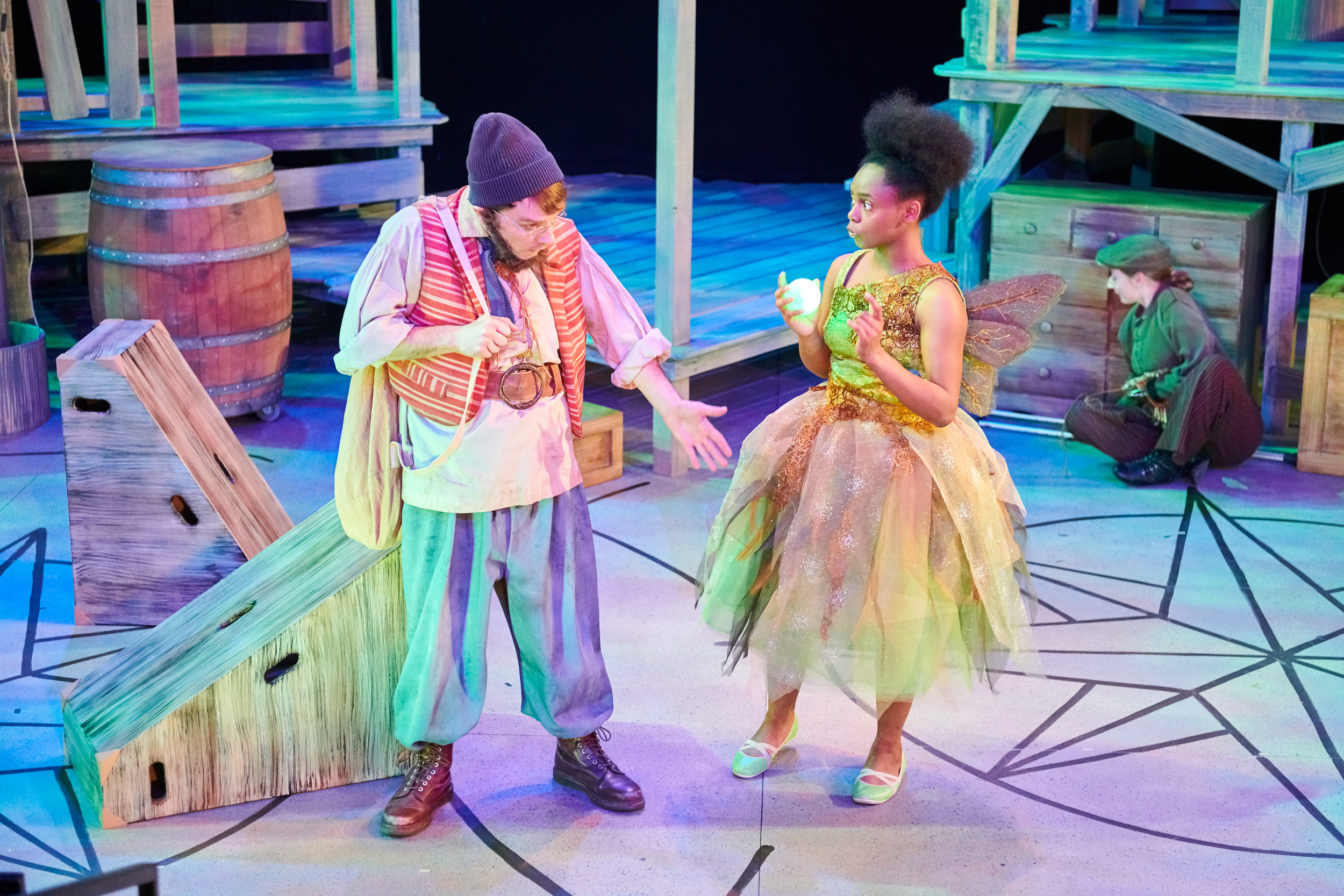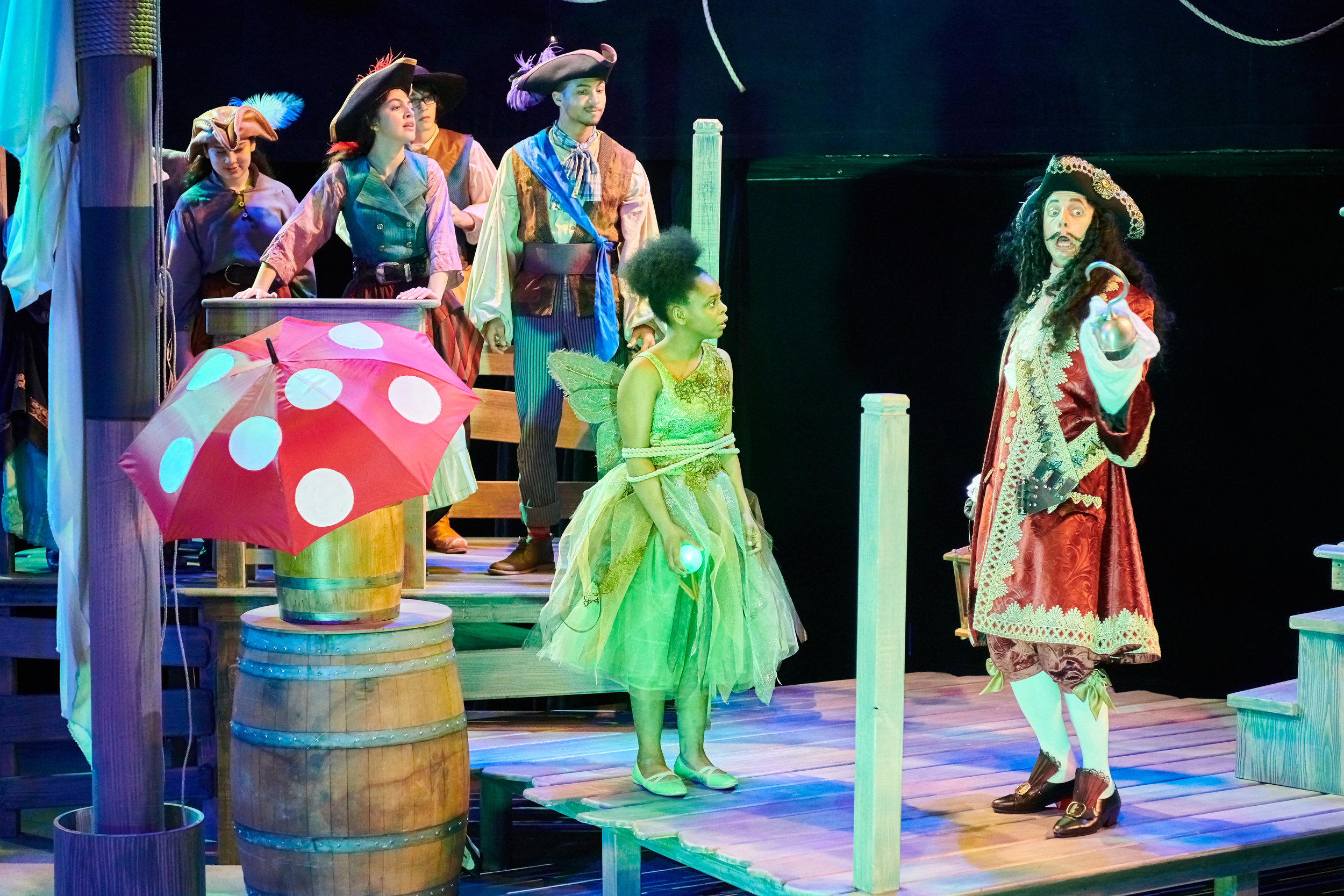Visual Magic Carries "Tinker Bell" at First Stage
Photo by Paul Ruffolo.
Like other literary classics, J.M. Barrie’s creation “Peter Pan” has been revisited by a lot of contemporary authors, spinning new stories inspired by the original. “Lost Girl,” “Peter and the Starcatcher,” and “Finding Neverland” have all graced Milwaukee stages in the past few years, examining the tale of “the boy who wouldn’t grow up” in new and illuminating ways. And now, after staging the OG “Peter Pan” and “Peter Pan and Wendy,” First Stage is venturing into the world of alternate interpretations again with “Tinker Bell,” a play for young audiences, adapted by Patrick Flynn and directed by First Stage Artistic Director Jeff Frank. Focusing on the glowing sprite that befriends Peter in Neverland, “Tinker Bell” includes most of the audience’s favorite characters and memorable moments from the original story, while examining the relationship between Tink and Peter and exploring the meaning of friendship.
At the top of the show we enter the world of Peter Pan, the lost boys and Captain Hook through Tinker Bell’s perspective. According to her (a spunky Chantae Miller in the Adventure Cast) the whole story started because she was lonely. Many of her fairy friends had disappeared from the island, due to children’s lack of faith in the magical creatures. Looking some new playmates, the winged fairy, bundled in layers of sparkly green tulle, flies to London and tries to strike up a conversation with a friendly stranger -- a goose. But then Peter arrives in the park, angry at his parents for planning his entire future -- as a baker! -- without consulting him. Furious, he flies with Tink away to Neverland and their adventures commence.
Problems come up for the magical playmates when the lost boys (and girls) beg to come to Neverland too. Tink resents having to share Peter’s attention and marvels at everyone’s illogical need for a mother. (According to the script, fairies can only experience one emotion at a time, so they have trouble understanding the complexities of friendship.) This combination of Tinker Bell’s jealousy, misunderstanding, love and hurt serve as the emotional spine of this story with vignettes involving pirates, sword fights and Wendy’s attempts to mother the lost children providing context for her quandaries.
Photo by Paul Ruffolo.
As the lovable pirate Smee, Chris Klopatek is an affable guide for the audience and also a trusted sounding board for Tinker Bell as she sorts out her feelings. Looking and sounding like he just wandered out of the Disney film, Klopatek provides just enough mischief to earn his “pirate” title, but not enough to frighten the younger audience members. Likewise, Ryan Schabach’s elegantly attired Captain Hook is more ridiculous than menacing. Clutching his teddy bear and running from the crocodile who took his hand and his clock, his brief appearances are milked for comedy rather than skullduggery.
In the lead roles (Adventure Cast) Chantae Miller’s Tink is well matched with Luca Batory’s Peter -- both very talented actors who are unafraid to make bold choices onstage. Miller imbues the normally fragile fairy with real strength and a point of view while Batory gives Peter Pan flashes of an adolescent’s rash behavior, balanced with equal impulses towards independence and a longing to return to their safe, loving family. This makes both magical friends sympathetic but complicated characters, which is refreshing in a children’s story.
Under Frank’s creative direction, “Tinker Bell” also packs a lot of visual magic into the 90-minute show, including beautifully crafted, miniature puppets that stand in for the characters when they fly, and an adorable dollhouse-sized scene of the Darling family nursery, where Peter meets Wendy, John and Michael. Often when Tink and Peter fly short distances, they are simply carried by other cast members, which also has an fantastical effect. Costumes by Theresa Ham are fanciful and luxurious while staying well within the standard Peter Pan aesthetic. Jason Fassl’s lighting design gives Tinker Bell a special glow, and the cast of young performers manipulate glowing, colorful orbs, representing the other fairies who popular Neverland.
Although the enormous dog Nanna doesn’t make an appearance in this version, some other captivating animals do. The geese that Tinker Bell tries to befriend in Kensington Gardens are flapping wooden push toys, their quacks provided by their handlers. And Captain Hook’s crocodile nemesis is an intricate, life-size wooden puppet covered in beige mesh fabric so his “bones” are clearly visible under his “skin.” This makes the reptile more fascinating than frightening, in line with the rest of the production.
Marketed to families with children six and up, there were many much younger attendees at the performance I saw on opening weekend -- many of them clad in Tinker Bell and other Disney Princess gowns. For them the slapstick humor and slow motion sword fights are just the right speed and the lesson about friendship seems appropriate. But it’s delivered at the expense of many pieces of the original story of Peter Pan, which makes the play feel disjointed. Those familiar with the book or movie can fill in the blanks but the didactic moral frequently feels shoehorned into a narrative where it doesn’t quite fit. Fortunately the talented cast and plethora of visual delights distracts from holes in the story and still delivers a magical afternoon.

